�
Preface
Copyright
This publication, including all photographs, illustrations and software, is protected under
international copyright laws, with all rights reserved. Neither this manual, nor any of the
material contained herein, may be reproduced without written consent of the author.
Version 1.1
Disclaimer
The information in this document is subject to change without notice. The manufacturer
makes no representations or warranties with respect to the contents hereof and specifically
disclaims any implied warranties of merchantability or fitness for any particular purpose.
The manufacturer reserves the right to revise this publication and to make changes from
time to time in the content hereof without obligation of the manufacturer to notify any
person of such revision or changes.
Trademark Recognition
Microsoft, MS-DOS and Windows are registered trademarks of Microsoft Corp.
AMD, Athlon, Sempron and Duron are registered trademarks of AMD Corporation.
Other product names used in this manual are the properties of their respective owners and
are acknowledged.
Federal Communications Commission (FCC)
This equipment has been tested and found to comply with the limits for a Class B digital
device, pursuant to Part 15 of the FCC Rules. These limits are designed to provide reason-
able protection against harmful interference in a residential installation. This equipment
generates, uses, and can radiate radio frequency energy and, if not installed and used in
accordance with the instructions, may cause harmful interference to radio communications.
However, there is no guarantee that interference will not occur in a particular installation.
If this equipment does cause harmful interference to radio or television reception, which
can be determined by turning the equipment off and on, the user is encouraged to try to
correct the interference by one or more of the following measures:
•
•
•
•
Reorient or relocate the receiving antenna.
Increase the separation between the equipment and the receiver.
Connect the equipment onto an outlet on a circuit different from that to which
the receiver is connected.
Consult the dealer or an experienced radio/TV technician for help.
Shielded interconnect cables and a shielded AC power cable must be employed with this
equipment to ensure compliance with the pertinent RF emission limits governing this
device. Changes or modifications not expressly approved by the system’s manufacturer
could void the user’s authority to operate the equipment.
Preface
�
ii
Declaration of Conformity
This device complies with part 15 of the FCC rules. Operation is subject to the following
conditions:
•
•
This device may not cause harmful interference, and
This device must accept any interference received, including interference
that may cause undesired operation.
Canadian Department of Communications
This class B digital apparatus meets all requirements of the Canadian Interference-causing
Equipment Regulations.
Cet appareil numérique de la classe B respecte toutes les exigences du Réglement sur le
matériel brouilieur du Canada.
About the Manual
The manual consists of the following:
Chapter 1
Introducing the Motherboard
Chapter 2
Installing the Motherboard
Chapter 3
Using BIOS
Describes features of the motherboard.
Go to page 1
Describes installation of motherboard
components.
Go to page 7
Provides information on using the BIOS
Setup Utility.
Go to page 23
Chapter 4
Using the Motherboard Software
Describes the motherboard software
Go to page 45
Chapter 5
VIA VT8237 SATA RAID Setup Guide
Provides information about SATA RAID
Setup
Go to page 49
Preface
�
iii
TTTTTABLE OF CONTENTS
ABLE OF CONTENTS
ABLE OF CONTENTS
ABLE OF CONTENTS
ABLE OF CONTENTS
Preface
i
Chapter 1
Introducing the Motherboard
1
1
Introduction................................................................................................1
Features.......................................................................................................2
Motherboard Components.......................................................................4
7 7 7 7 7
Chapter 2
Installing the Motherboard 7
Safety Precautions......................................................................................7
Choosing a Computer Case.......................................................................7
Installing the Motherboard in a Case......................................................7
Checking Jumper Settings.........................................................................8
Setting Jumpers..............................................................................8
Checking Jumper Settings..............................................................9
Jumper Settings..............................................................................9
Connecting Case Components...............................................................10
Front Panel Header.....................................................................11
Installing Hardware...................................................................................12
Installing the Processor...............................................................12
Installing Memory Modules.........................................................14
Installing a Hard Disk Drive/CD-ROM/SATA Hard Drive........16
Installing a Floppy Diskette Drive...............................................18
Installing Add-on Cards..............................................................18
Connecting Optional Devices......................................................20
Connecting I/O Devices..........................................................................22
Chapter 3
Using BIOS
23 23 23 23 23
23
About the Setup Utility............................................................................23
The Standard Configuration........................................................23
Entering the Setup Utility..............................................................23
Updating the BIOS.......................................................................25
Using BIOS................................................................................................25
Standard CMOS Features...........................................................26
Advanced BIOS Features.............................................................28
Advanced Chipset Features.........................................................30
�
iv
Integrated Peripherals.................................................................32
Power Management Setup...........................................................36
PNP/PCI Configurations.............................................................39
PC Health Status..........................................................................40
Frequency/Voltage Control..........................................................41
Load Fail-Safe Defaults................................................................42
Load Optimized Defaults.............................................................42
Set Supervisor/User Password....................................................42
Save & Exit Setup Option.............................................................43
Exit Without Saving......................................................................43
Chapter 4
Using the Motherboard Software
45 45 45 45 45
45
About the Software CD-ROM................................................................45
Auto-installing under Windows 98/ME/2000/XP................................45
Running Setup..............................................................................46
Manual Installation..................................................................................48
Utility Software Reference.......................................................................48
Chapter 5
SIS964 SATA RAID Setup Guide
49 49 49 49 49
49
Introduction for SiS964 SATA RAID Function....................................49
Features......................................................................................................49
Support Operating Systems....................................................................49
What is RAID............................................................................................49
Installing Software Drivers......................................................................50
BIOS Utility Operation.............................................................................51
Multi-Language Translation
�
1
Chapter 1
Introducing the Motherboard
Introduction
Thank you for choosing the 760GX-M motherboard. This motherboard is a high perfor-
mance, enhanced function motherboard that supports Socket 754 AMD K8 processors for
high-end business or personal desktop markets.
The motherboard incorporates the SiS760GX Northbridge (NB) and SiS964 Southbridge
(SB) chipsets. The SiS760GX Northbridge features the HyperTranportTM complaint bus
driver technology to support AMD K8 processors up to 1600MT/s data rate. The
Northbridge supports external AGP slot with AGP 8X/4X capability and Fast Write Trans-
actions. Plus, SiS MuTIOL, a high bandwidth and mature technology, is incorporated to
connect SiS760GX and SiS964 MuTIOL Media IO together.
The SiS964 Southbridge supports Hi-Precision Event Timer (HPET) for Microsoft Win-
dows with multiple DMA bus architecture that supports isochroous request and continuous
packet transmission. It implements an EHCI compliant interface that provides 480Mb/s
bandwidth for eight USB 2.0 ports, integrates AC’97 v2.3 compliant audio controller that
features a 6-channels of audio speaker out and HSP v.90 modem support. The Southbridge
integrates a Serial ATA host controller that is SATA v1.0 compliant, and supports 1.5Gb/s
bandwidth for each serial port. It provides dual independent IDE channels and each of them
support PIO mode 0,1,2,3,4 and multiword DMA mode 0,1,2 and UltraDMA 133/100/66.
There is an advanced full set of I/O ports in the rear panel, including PS/2 mouse and
keyboard connectors, COM1, LPT1,VGA port and four USB ports, one optional LAN port,
and audio jacks for microphone, line-in, and line-out. This motherboard is designed in a
Micro ATX form factor using a four-layer printed circuit board and measures 244 mm x 244
mm.
Introducing the Motherboard
�
2
Feature
Processor
This motherboard uses a 754-pin socket that carries the following features:
•
•
Accommodates AMD K8 processors
Supports HyperTransport interface for AMD K8 processors
T M
T M
HyperTransport Technology is a point-to-point link between two devices, it enables
integrated circuits to exchange information at much higher speeds than currently avail-
able interconnect technologies.
Chipset
The SiS760GX Northbridge (NB) and SiS964 Southbridge (SB) chipset are based on an
innovative and scalable architecture with proven reliability and performance.
SiS760GX(NB)
SiS964 (SB)
Memory
•
•
•
•
•
•
•
•
•
•
T M
SiS MuTIOL is incorporated to connect SiS760GX and
SiS964 MuTIOL Media IO together
Supports HyperTransport Technology up to 1600MT/s
bandwidth
AGP v3.0 compliant with 8X/4X and fast write transaction
Supports up to 128MB display memory with shared memory
Built-in a high performance 256-bit 3D Graphics engine
with DirectX 8.1 supported
Concurrent servicing of all DMA Devices: Dual IDE Control-
lers, SATA controller, three USB 2.0/1.1 host controller,
LAN MAC Controller and Audio/Modem DMA Controller
Compliant with PCI 2.3 specificaiton supporting up to 6 PCI
masters
Compliant with Serial ATA 1.0 specification, supports power
saving mode
Compliant with AC’97 v2.3 supporting 6 Channels of audio
outputs
Integrated USB 2.0/1.1 Host Controllers supporting up to
eight ports
•
•
•
Supports DDR400/333/266/200 memory types
Accommodates two unbuffered 2.5V 184-pin DDR SDRAM DIMM sockets
A total maximum capacity 2 GB
Graphics
Built-in 32-bit floating point format VLIW triangle setup engine
Built-in an 1T pipelined 128-bit BITBLT graphics engine
Built-in a high quality 3D engine
Supports up to 4 textures
•
•
•
•
•
•
•
•
AC’97 Audio CODEC
Compliant with AC’97 v2.3 specification
High quality differential CD input
Supports double sampling rate (96KHz) of DVD audio playback
Direct Sound 3D compatible
TM
Introducing the Motherboard
�
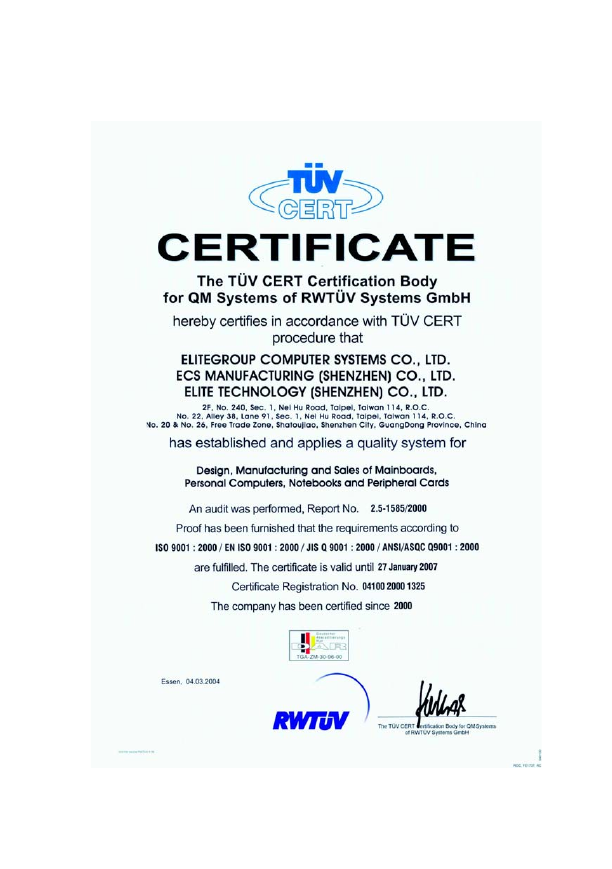
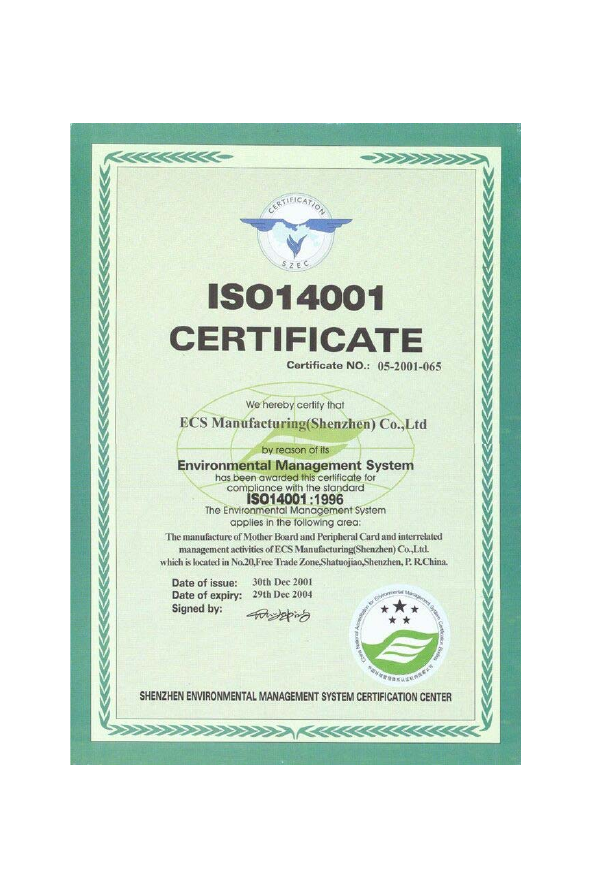
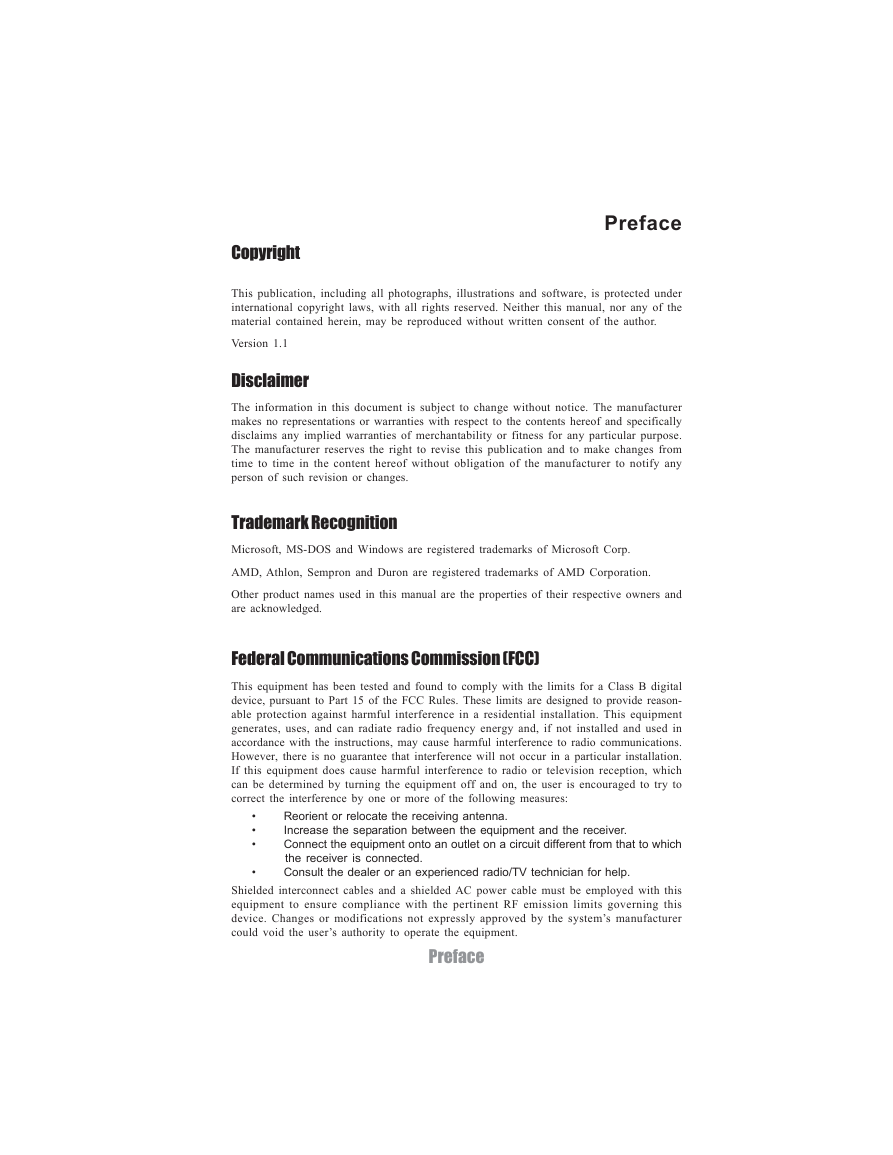
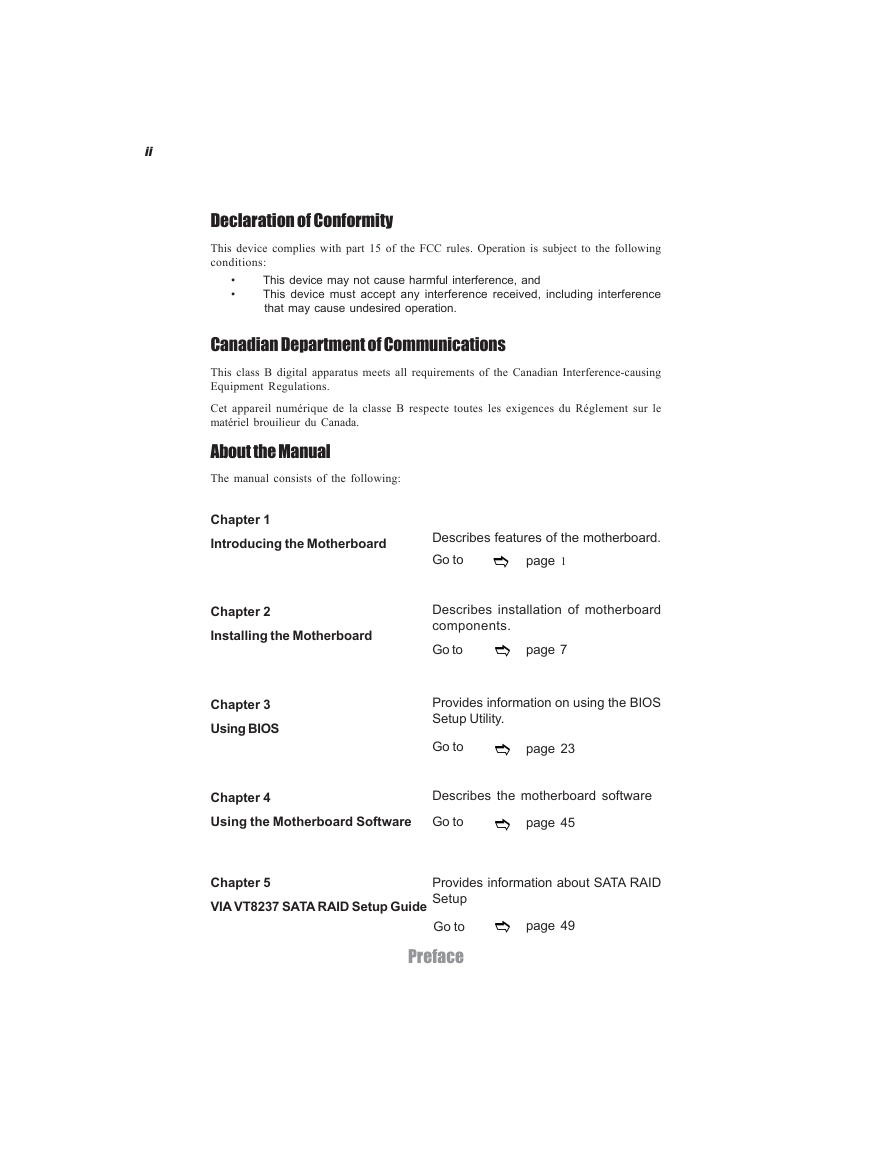

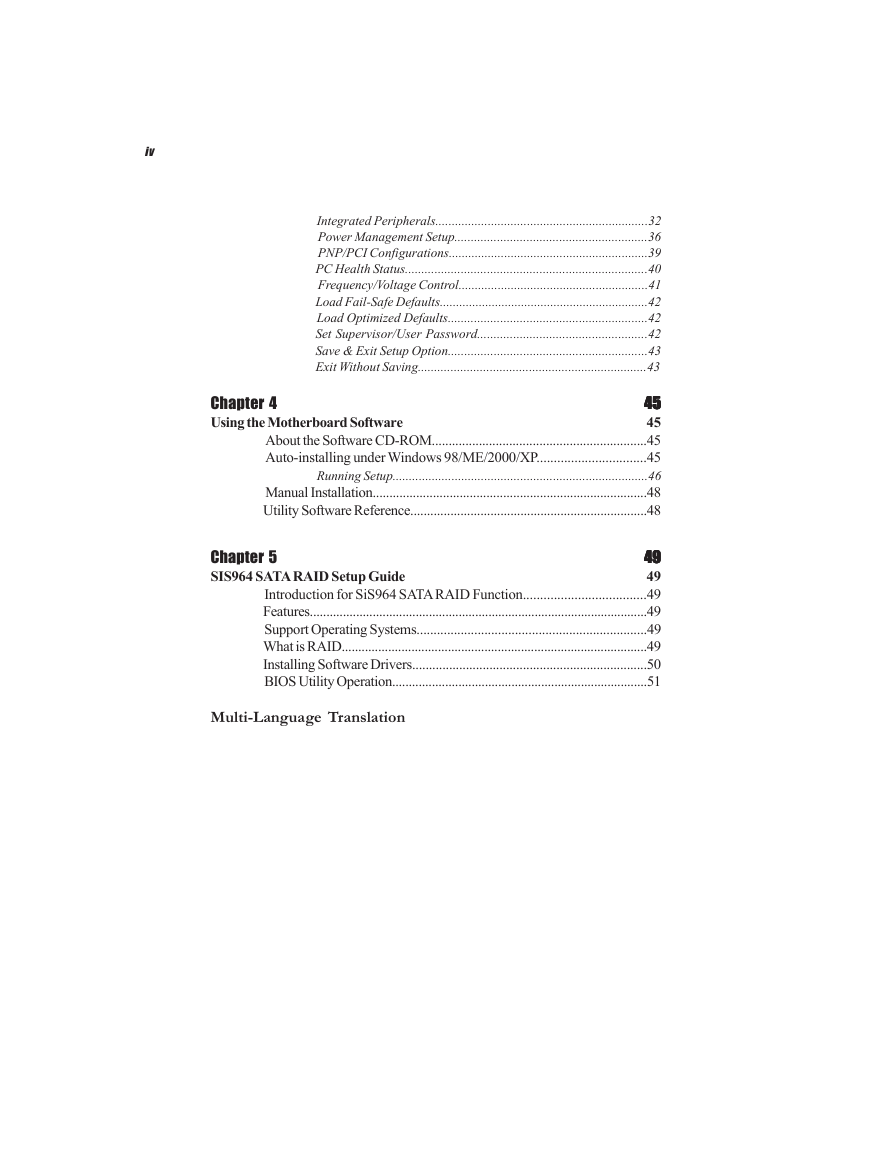
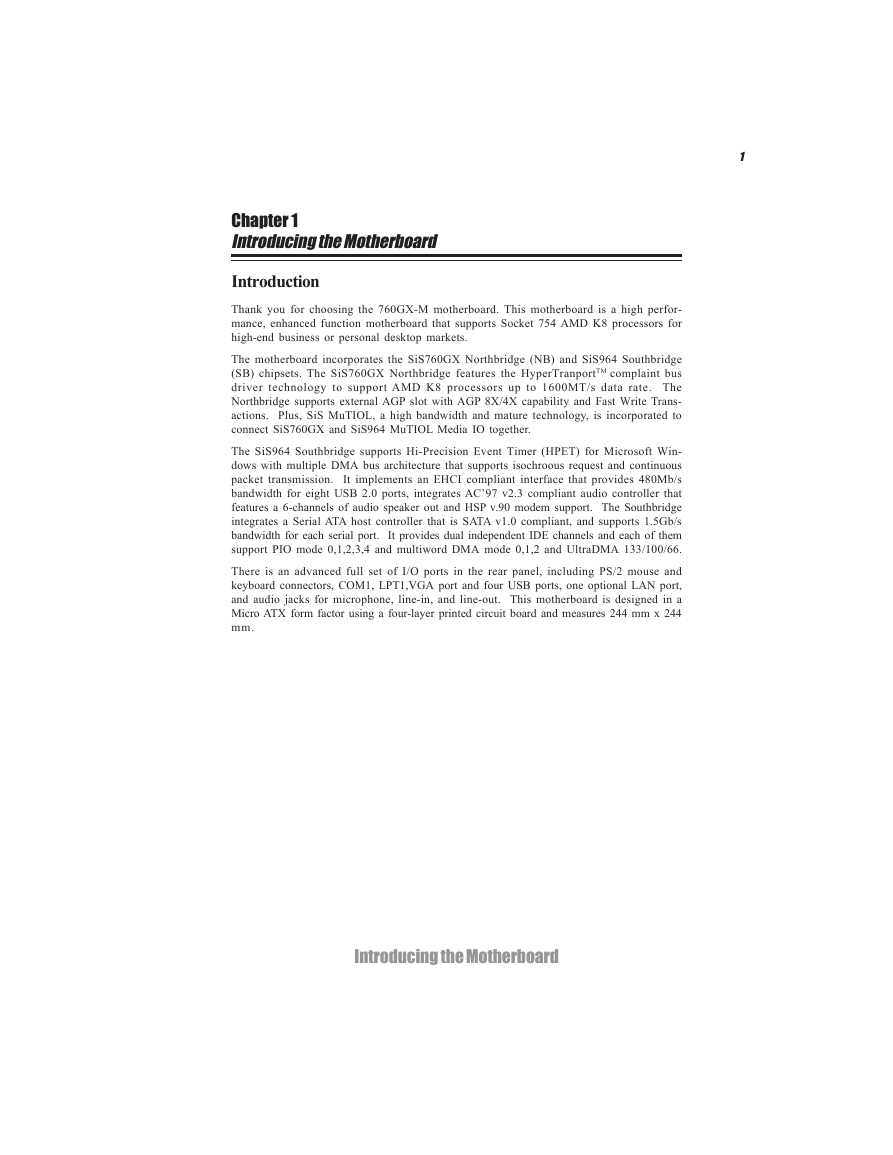
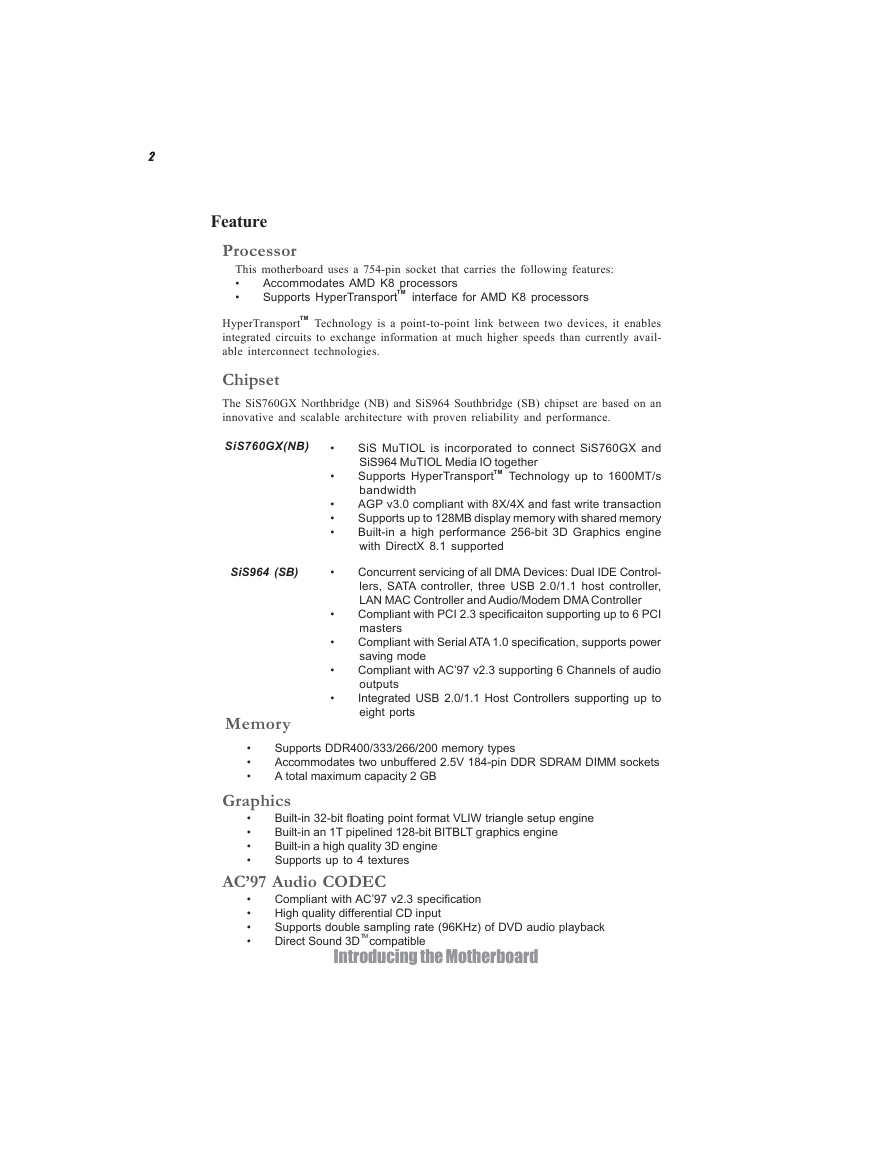








 2023年江西萍乡中考道德与法治真题及答案.doc
2023年江西萍乡中考道德与法治真题及答案.doc 2012年重庆南川中考生物真题及答案.doc
2012年重庆南川中考生物真题及答案.doc 2013年江西师范大学地理学综合及文艺理论基础考研真题.doc
2013年江西师范大学地理学综合及文艺理论基础考研真题.doc 2020年四川甘孜小升初语文真题及答案I卷.doc
2020年四川甘孜小升初语文真题及答案I卷.doc 2020年注册岩土工程师专业基础考试真题及答案.doc
2020年注册岩土工程师专业基础考试真题及答案.doc 2023-2024学年福建省厦门市九年级上学期数学月考试题及答案.doc
2023-2024学年福建省厦门市九年级上学期数学月考试题及答案.doc 2021-2022学年辽宁省沈阳市大东区九年级上学期语文期末试题及答案.doc
2021-2022学年辽宁省沈阳市大东区九年级上学期语文期末试题及答案.doc 2022-2023学年北京东城区初三第一学期物理期末试卷及答案.doc
2022-2023学年北京东城区初三第一学期物理期末试卷及答案.doc 2018上半年江西教师资格初中地理学科知识与教学能力真题及答案.doc
2018上半年江西教师资格初中地理学科知识与教学能力真题及答案.doc 2012年河北国家公务员申论考试真题及答案-省级.doc
2012年河北国家公务员申论考试真题及答案-省级.doc 2020-2021学年江苏省扬州市江都区邵樊片九年级上学期数学第一次质量检测试题及答案.doc
2020-2021学年江苏省扬州市江都区邵樊片九年级上学期数学第一次质量检测试题及答案.doc 2022下半年黑龙江教师资格证中学综合素质真题及答案.doc
2022下半年黑龙江教师资格证中学综合素质真题及答案.doc